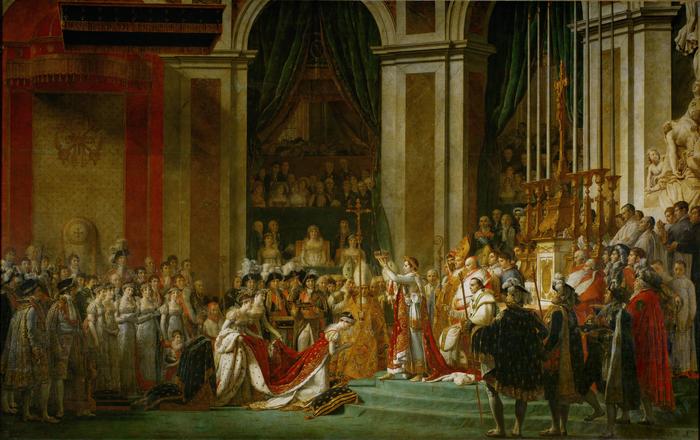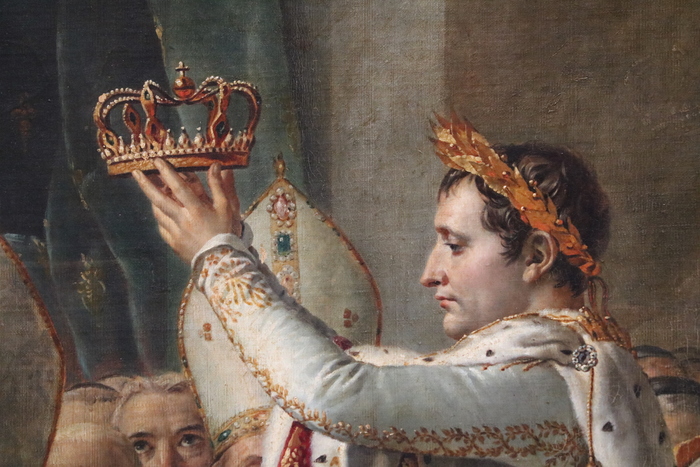Art Lovers discussion
Questions from the Met
>
History in Art
date newest »
newest »
 newest »
newest »
message 1:
by
Heather
(new)
Jul 25, 2019 12:03PM
 Do you enjoy learning about history through art? Can you (and/or do you) trust an artist’s interpretation?
Do you enjoy learning about history through art? Can you (and/or do you) trust an artist’s interpretation?
reply
|
flag
 I do...I think one can trust the history by an artist as much as a history by the historians...isn't it said that history is the story written by the ruling side or the conquering side...so all will have their bias..I think...
I do...I think one can trust the history by an artist as much as a history by the historians...isn't it said that history is the story written by the ruling side or the conquering side...so all will have their bias..I think...
 I am in waiting in an extremely long line, luckily I am indoors and there is air conditioning! I have been here for almost 45 minutes now with no end in sight but I will attempt to attend to my favorite art group!
I am in waiting in an extremely long line, luckily I am indoors and there is air conditioning! I have been here for almost 45 minutes now with no end in sight but I will attempt to attend to my favorite art group! My brain might be a little bit melted at the moment but I hope you will help me come up with some artwork that has told some stories from history. So far the ones I’ve thought of consist of Greek myths and Bible stories and there are quite a few of those! Unfortunately, I can’t post any pictures from my phone so those will have to come later.
 So what you’re saying is you do think one can believe history as portrayed by an artist? Or are you saying the artist is biased in some way?
So what you’re saying is you do think one can believe history as portrayed by an artist? Or are you saying the artist is biased in some way?
 I do like learning history through the eyes of an artist, whether he or she is biased or not. Especially when mythology is being portrayed. I really enjoy the sculptures of Apollo and Daphne or Laocoon and his Sons or the paintings of Medusa by various artists... or Venus also by numerous artists...
I do like learning history through the eyes of an artist, whether he or she is biased or not. Especially when mythology is being portrayed. I really enjoy the sculptures of Apollo and Daphne or Laocoon and his Sons or the paintings of Medusa by various artists... or Venus also by numerous artists...I enjoy learning about the stories behind the paintings or statues.
 I think they are sources from which we can learn a lot..I just meant..they record things visually and the historians through words and writers or storytellers through their stories and plays..and both may have their faults..but ,in their own way both are sources which provide a great deal of knowledge about our past..
I think they are sources from which we can learn a lot..I just meant..they record things visually and the historians through words and writers or storytellers through their stories and plays..and both may have their faults..but ,in their own way both are sources which provide a great deal of knowledge about our past..In short my answer is ..Yes ,we can learn from the artists...
As to the work of art..I am sorry,Heather ..I don't know..I think a more knowledgeable person may know it..
 I think the Dutch painters like Vermeer and the Impressionist painters who recorded what they saw .. shows us the atmosphere, day to day life ,what the people wore.. that sort of history...
I think the Dutch painters like Vermeer and the Impressionist painters who recorded what they saw .. shows us the atmosphere, day to day life ,what the people wore.. that sort of history...And the various portraits done by all the great artists have recorded great personalities..and in some cases they may have captured the personality and the attitudes of the people of that time...
 Oh, I see what you’re saying! Yes! You’re totally right! You’re saying they tell the history, or their story in their way of speaking... through art, or pictures or statues or however they portray it whereas others do in words or music or however. I see where you’re coming from.
Oh, I see what you’re saying! Yes! You’re totally right! You’re saying they tell the history, or their story in their way of speaking... through art, or pictures or statues or however they portray it whereas others do in words or music or however. I see where you’re coming from.
 As for the actual history part through paintings just remembered reading something about Waterloo paintings and all...
As for the actual history part through paintings just remembered reading something about Waterloo paintings and all...So googled it.. and got..
https://www.historyhit.com/iconic-pai...
 World war 1
World war 1 https://www.iwm.org.uk/history/6-stun...
Wow!
I didn't know there were War Artists..
There must be lots of photography too from then on..
 Wow! That is incredible in so many different ways!
Wow! That is incredible in so many different ways! Women artists for one thing, during the First World War when women were esteemed so much less than men in the war as well as careers and the arts.
They paint about several callings that they fill in the call of duty and some even go on to paint afterward and are even commissioned to do so.
So cool! Thank you for being that up, Now that’s history!
 The one painting that immediately springs to mind is the coronation of Napoleon by David.
The one painting that immediately springs to mind is the coronation of Napoleon by David.I saw it in the Louvre (no crowd before it, strange?)
https://en.wikipedia.org/wiki/The_Cor...


 That’s a great one! Such detail, it seems so busy yet encompassing what’s relevant to the picture. There is so much to look at.
That’s a great one! Such detail, it seems so busy yet encompassing what’s relevant to the picture. There is so much to look at.


The Second of May, 1808
Francisco Goya
1814
In 1807, Napoleon, bent on conquering the world, brought Spain’s king, Charles IV, into alliance with him in order to conquer Portugal. Napoleon’s troops poured into Spain, supposedly just passing through. But Napoleon’s real intentions soon became clear: the alliance was a trick. The French were taking over. Joseph Bonaparte, Napoleon’s brother, was the new king of Spain.

The Third of May in Madrid, 1808
Francisco Goya
1814-1815
On May 2, 1808, hundreds of Spaniards rebelled. On May 3, these Spanish freedom fighters were rounded up and massacred by the French. Their blood literally ran through the streets of Madrid. Even though Goya had shown French sympathies in the past, the slaughter of his countrymen and the horrors of war made a profound impression on the artist. He commemorated both days of this gruesome uprising in paintings. Although Goya’s Second of May (above) is a tour de force of twisting bodies and charging horses reminiscent of Leonardo’s Battle of Anghiari, his The Third of May, 1808 in Madrid is acclaimed as one of the great paintings of all time, and has even been called the world’s first modern painting.

The Third of May (detail)
We see row of French soldiers aiming their guns at a Spanish man, who stretches out his arms in submission both to the men and to his fate. A country hill behind him takes the place of an executioner’s wall. A pile of dead bodies lies at his feet, streaming blood. To his other side, a line of Spanish rebels stretches endlessly into the landscape. They cover their eyes to avoid watching the death that they know awaits them. The city and civilization is far behind them. Even a monk, bowed in prayer, will soon be among the dead.

The Third of May (detail)
Goya’s painting has been lauded for its brilliant transformation of Christian iconography and its poignant portrayal of man’s inhumanity to man. The central figure of the painting, who is clearly a poor laborer, takes the place of the crucified Christ; he is sacrificing himself for the good of his nation. The lantern that sits between him and the firing squad is the only source of light in the painting, and dazzlingly illuminates his body, bathing him in what can be perceived as spiritual light. His expressive face, which shows an emotion of anguish that is more sad than terrified, echoes Christ’s prayer on the cross, “Forgive them Father, they know not what they do.” Close inspection of the victim’s right hand also shows stigmata, referencing the marks made on Christ’s body during the Crucifixion.
The man’s pose not only equates him with Christ, but also acts as an assertion of his humanity. The French soldiers, by contrast, become mechanical or insect-like. They merge into one faceless, many-legged creature incapable of feeling human emotion. Nothing is going to stop them from murdering this man. The deep recession into space seems to imply that this type of brutality will never end.
https://www.khanacademy.org/humanitie...


